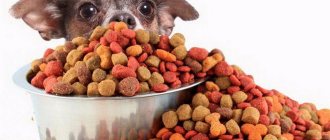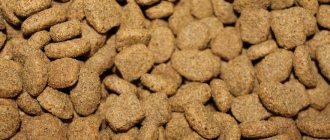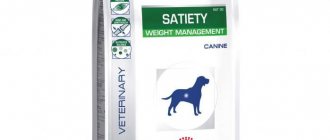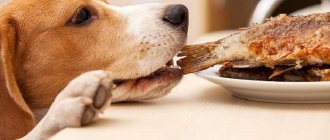10.01.2019
What to feed your dog: dry food or natural food? The eternal battle of drying versus natural.
Anyone who decides to have a four-legged friend sooner or later faces the question of whether it is better to feed the dog dry food or natural food? Each type of food has its pros and cons, which can play a decisive role in choosing a diet for your pet. Before we look in more detail at the main advantages of each type of food, we should clarify what is included in the concept of a healthy diet and what a pet’s daily menu should look like.
First of all, I would like to clarify that natural feeding is not food from the owner’s table. Cooking porridge and throwing in a few bones or pouring leftover soup into a bowl is a direct way to undermine the animal’s health. The popular opinion “before dogs ate everything and lived normally” is erroneous and dangerous. Of course, an animal can survive on such meager rations, but this will greatly affect its health:
- The lifespan of a dog with proper feeding and care is about 13 years. Moreover, even at an advanced age, a pet can remain cheerful and beautiful. If you neglect to properly feed the animal, its lifespan will be significantly shorter, and after 6 years serious health problems will begin. The most common of them are: Joint diseases, muscle weakness and weight gain, which leads to decreased activity.
- Tooth loss.
- Various gastrointestinal diseases can lead to diabetes, uncontrolled bowel movements and incontinence.
For a natural diet to be considered healthy, you must follow the following rules:
- The basis of the dog’s diet should be lean, sinewy meat – 60-70%. Beef, horse meat, and rabbit are the most suitable types of meat for dogs, while lamb and pork contain too much fat. The menu must include meat by-products: heart, liver, kidneys, stomachs, lungs, tripe - they contain useful vitamins and microelements. Meat and offal must be heat treated to destroy helminth eggs and eliminate the risk of infecting your pet with worms.
- The remaining 30-40% are cereals, vegetables and fruits as a source of carbohydrates. Of the cereal crops that are suitable for dogs to eat, rice, buckwheat and rolled oats, the rest are not absorbed by the animal’s body, irritate the mucous membrane of the digestive system and provoke diarrhea. Vegetables in your dog’s diet should include carrots, zucchini, and pumpkin, but cabbage, potatoes and beets are prohibited.
- When feeding natural food, it is necessary to include vitamin supplements, fertilizers and mineral complexes in the diet, because not all nutrients and microelements are absorbed by the body in the required quantities.
- Food temperature should be 25-35°C
- Meals should be fractional and divided into 3-4 meals
- The menu should be balanced and based on the individual needs of the breed, age and physical characteristics of the animal. The owner must have enough knowledge and time to draw up a feeding plan for the week and prepare it every day.
- The products from which pet food is prepared must be of high quality. Vegetables without chemical additives, and meat without antibiotics.
Dry or natural food: what to choose
Even experienced owners often defend their point of view regarding feeding their faithful charges, giving preference to one diet or another. Let's try to figure out what is the best way to feed a dog? Dry or natural: what to choose for your pet?
Dogs can be kept either on ready-made industrial food or on a natural diet. When choosing the type of food, consider not only the nutritional and energy value of food, but also the following aspects:
- age, breed characteristics of the dog;
- health status;
- activity level;
- individual, physiological characteristics;
- taste preferences;
- availability of free time, financial capabilities.
Important! Up to a year, the dog must be accustomed to a certain diet, regimen, schedule, and feeding system. Don't change your diet suddenly unless necessary.
Regardless of what type of feeding you prefer, the basic rule of a balanced, proper diet is that the dog’s nutrition should 100% satisfy the animal’s daily needs, not only in energy terms, but also in vitamins, minerals, and amino acids.
If a dog is deficient in useful, biologically active substances, sooner or later this will lead to exhaustion, weakened immune activity, decreased body resistance, weight loss, and other health problems. Puppies will lag behind their peers in growth and development.
It doesn’t matter whether the dog is kept on a natural diet or a ready-made diet, malnutrition, as well as overeating, can later result in serious systemic functional disorders and disruptions in the gastrointestinal tract.
Improving the condition of fur, skin and pigment!
Another fairly rapid change is the condition of the coat and skin! The wool becomes much softer to the touch. Stops getting greasy quickly after washing. tangles and smells much nicer! The general condition of the skin also improves over time if the problems were caused by poor nutrition.
Cleansing the anal glands
Unfortunately, in dogs that eat dry food, and even more often in those that eat canned soft food, the stool does not have sufficient density to clean the paraanal glands during defecation. It is often too loose and pate-like. Because of this, the glands are not cleaned regularly, which leads to stagnation of secretions in them and, as a result, leads to inflammation. When dogs are fed raw meat, with the obligatory addition of a bone component, the dog's stool has a much greater density and the glands function normally. This is an excellent prevention of this problem, which usually does not occur in dogs on a properly balanced diet.
Natural feeding
According to many breeders and veterinarians, it is natural feeding that is more acceptable and beneficial for our smaller brothers, since such a diet, in fact, is provided by nature itself. After all, dogs used to eat only natural products, and not ready-made aromatic dry granules, balls or aromatic pads in sauces or jelly.
Products for a natural diet:
- Lean meat (veal, beef, lamb, rabbit).
- Poultry (turkey, chicken, quail meat).
- Low-fat varieties of oceanic and sea fish (tuna, talapia, white, pollock).
- Fermented milk and dairy products (calcified cottage cheese, skim milk, fermented baked milk, kefir, low-fat cream, sour cream, yoghurts without additives and fillers, whey).
- Cereals, cereals. Among the porridges that can be cooked in water, milk, low-fat meat and fish broths, dogs are given buckwheat, rice, wheat groats, and oatmeal. You can cook a mix of two or three cereals.
- Offal (chicken offal, veal liver, tongue, tripe, lungs). They have a lower nutritional energy value, so the portion should be increased by one and a half to two times.
- Chicken and quail eggs. They are given 1-2 times a week in raw, boiled form. Eggs can be added to dairy products.
- Vegetables, herbs, fruits. Supplement your diet with fresh herbs, stewed, raw, finely grated vegetables. For better absorption, season raw vegetables with vegetable oil. As for fruits, do not give your dog too many juicy and sweet fruits.
- Bones. Dogs enjoy chewing bones. They help remove plaque and improve the condition of the gums. Give your pet only strong, not brittle bones.
Undoubtedly, this diet for dogs has its pros and cons, which will be discussed further.
Pros and cons of natural dog food
Giving preference to natural food, we recommend that you learn about the advantages and disadvantages of this type of diet.
Pros of natural feeding:
- individual approach to menu creation;
- confidence in the quality and freshness of food;
- the ability to create a varied menu;
- the ability to combine various products in the dog’s menu;
- ease of adjusting the diet if necessary.
The main advantage of natural food is its natural composition, the absence of chemicals, dyes, flavors, and other substances unsafe for animals.
Disadvantages of natural diets:
- The owner must strictly maintain a balanced diet, the ratio of proteins, carbohydrates, and fats.
- It is important to correctly calculate the serving size for a dog, taking into account age, load, and breed.
- A natural diet requires time. Products must be prepared specifically for your pet. Food from our table leads to intestinal disorders and disturbances in the functioning of the gastrointestinal tract.
- The diet is supplemented with vitamins and minerals.
Water norm
The dog must have free access to fresh drinking water. The amount of water is determined by the dog’s age, time of year, and level of activity. In summer, dogs drink more water than in winter, but regardless of the time of year, do not limit your dog's drinking water.
Use soft, separated, filtered, bottled water without gas. Change the water in the bowl twice a day.
Ready-made dry food
A ready-made diet is profitable, fast, and convenient. Due to time savings, many breeders choose this food for their pets. But are all ready-made dry food, canned food, pates good for animals?
Pros and cons of ready-made diets
Like natural feeding, a ready-made diet has its pros and cons, which owners should take into account when choosing the type of food.
Advantages of ready-made feed:
- Save time.
- A wide variety of tastes, a wide range.
- Dry food has a long shelf life. You can take them with you on the road or use them as encouragement when learning.
- Convenient dosage. The manufacturer indicates on the packaging approximate daily doses according to the weight and age of the dogs.
- Ready-made foods (therapeutic, preventive) are often prescribed by veterinarians for weakened animals or when dogs are diagnosed with systemic diseases and pathologies.
High-quality dry, wet, and canned food have a completely balanced composition, therefore, unlike natural food, such a diet does not need to be additionally enriched with vitamin supplements.
You can choose food taking into account the breed, age, taste preferences, and individual characteristics of the dog. Many brands produce products for certain breeds, lactating and pregnant bitches, and animals with sensitive digestive tracts. There is dietary food, therapeutic and preventive food.
Among the disadvantages, we can note the high cost of production, since animals can only be fed with high-quality ready-made feed. In addition, finished products are addictive and after a ready-made diet, some dogs are difficult to switch to natural food.
Feed classes
The quality of industrial feeds is indicated by their category. The higher the category, the higher the nutritional value and quality of the food.
Feed classes:
- Economy
- Premium
- Super premium.
- Elite.
- Holistic.
Consumer-grade products have a low cost, but they should not be used to feed your pet due to the content of artificial components and chemical additives (stabilizers, dyes, flavors). They are made from low-quality, low-grade raw materials. These foods contain soy and grains.
Only food of the “Super-premium”, “Premium”, “Elite” categories has a fully balanced composition of minerals, vitamins, proteins, fats, and carbohydrates.
Choosing the right dog food
As already noted, use food of the highest category for feeding. The best ready-made dog foods come from the following brands:
- Acana.
- 1st Choice (Fest Choice).
- Eukanuba.
- Trainer.
- Josera.
- Arden Grange.
- Monge.
- Brit Care.
- Pronature Original.
- Gina.
- Nutram.
- Bosch.
- Barking Heads.
- Optima Nova.
- DailyDog.
When choosing food, consider the age, weight and body characteristics of your dog. For dogs prone to food allergies, pets with a sensitive gastrointestinal tract, give preference to holistic ones (Orijen, Grandorf, Now Fresh). Made only from natural ingredients. The composition is supplemented with enzymes, probiotics, vitamins, and substances that improve digestion.
Before buying food, carefully study the information on the back of the package and its composition, look at the expiration date.
Water norm
The amount of water for a prepared diet is unlimited. There should always be access to fresh water, which needs to be changed twice a day.
conclusions
Everyone puts their thoughts into the concept of “food as close to natural as possible.” Some people focus on consistency, others on composition. But there is one “BUT”. A wild animal, in order to survive, will eat everything that seems edible to it. In conditions of hunger and shortages, you can’t make much choice. Just like a person in extreme situations can live on roots alone for a long time. But if there is a choice and opportunity, who and why will deliberately make their diet poor in vitamins and nutrients? Who will benefit from this? The science of healthy eating, zoology and dietetics do not stand still; today people know much more about proper nutrition both for themselves and for the animal. It is impossible to compare the first attempts to create food and dry rations, which are now produced under the strict supervision of specialists. Many years of research have made it possible to find out the basic needs of the body and produce dry food in accordance with the characteristics of the dog’s body, so that pets live longer, are healthy and beautiful. Only the owner can choose what to feed the pet. If you approach your dog’s daily diet responsibly and thoroughly study the features of each type of food, any of the options will be good.
When making a decision, you should realistically assess your strengths.
Natural feeding requires time, constant monitoring and deep immersion in the literature on proper nutrition. The question is very serious, laziness and “maybe” are unacceptable. By choosing dry food, some of the worries will fall off the owner’s shoulders, but studying the ingredients and careful selection is also required. You can’t grab the first food you come across and, without learning anything about it, pour it in heaps to your pet. Between economy food and natural food, it is better to go with the second option. And in the case when the debate is between natural food and dry food of premium class and higher, weigh your strengths, but dry diets usually win on all counts.
Mixed feeding
Many veterinarians agree that dogs, like other pets, should not be kept on a combination diet. Mixed feeding is not the best nutrition choice for your pet. That is, you should not give your animal fresh food and industrial feed at the same time. If the dog receives ready-made food, you can alternate dry granules with patchouli, pates, mousses, pates, and canned food.
Important! Combination feeding often provokes chronic gastrointestinal diseases and leads to disruption of metabolic processes. This diet is not suitable for puppies, dogs with digestive problems, animals prone to food allergies, and elderly pets.
Be sure to alternate drying with canned food and wet food. You cannot feed dogs only dry or wet food. Use products from the same brand.
Prevention of tartar
An important change after switching over and incorporating proper raw bones is cleaning your teeth! In just a couple of months, even in dogs with advanced tartar, this problem goes away. Teeth become white, like after ultrasonic cleaning. Which may and will never be needed again.
Maintenance costs are reduced!
We sincerely believe that by choosing the right natural food for our dogs, we are investing in their health. And this pays off in a noticeable reduction in the number of trips to veterinary clinics and consultations with specialists. After switching our dogs to an all-natural, balanced diet, we stopped thinking about allergies, tartar in dogs, coat and digestive problems, and many other diseases that dogs that eat dry food are susceptible to. We love it!
Puppy's first feeding
The puppy can start feeding its first food at three to four weeks of age. Essentially, this is a smooth transition from mother's milk to an adult diet. Their harmonious development and health depends on how correctly you organize complementary feeding for puppies.
The first feeding can be started as soon as the puppies are 3-4 weeks old. Up to 2-2.5 months, use special mixtures, mousses, pates for puppies (starter food). Food should be in mushy, liquid form. The mixtures must be fresh and have a temperature of 37-38 degrees.
For large litters, it is permissible to use dog milk substitutes for complementary feeding, which are sold in veterinary pharmacies and pet stores.
From 3-3.5 months you can give your puppy minced chicken, boiled chicken, turkey meat, veal. You can also give calcined cottage cheese, low-fat cream, kefir, natural yoghurts, oatmeal with milk and water. From four months you can gradually accustom your little pet to solid natural food.
Important! For complementary foods, use food or products that you plan to feed the dog in the future.
For the first time (up to 3 months), soak dry food marked “For puppies” in warm water (temperature 50-55 degrees), milk, and kefir. Wet food is diluted with water in a ratio of 1/1. Gradually reduce the amount of water used to soften food as your pet gets older.
Introduce new foods gradually into your diet. Monitor your pet's condition. If a product or food causes a disorder or an allergy, it is removed from the diet.
If the first complementary foods provoked diarrhea, vomiting, or changed the consistency of the stool, the complementary foods are canceled for a day until the condition normalizes and the amount of complementary foods is halved in the following days. The volume of portions is increased gradually.
About dog nutrition
Even children today know about the need for a balanced diet for people and their little brothers. But let nutritionists, owners of pet restaurants and other advanced citizens do the exact calculation of the ratio of proteins, fats and carbohydrates in the daily menu, and we will talk about the basic rules of feeding at the user level.
So, a puppy, or an already grown-up dog, appeared in our house. The reasons for its appearance, role and hopes may be different:
- a friend, just a friend, another family member, sometimes also her decoration;
- friend and protector of people and property;
- future champion and winner of various exhibitions;
- it happened (they brought the kids, he jumped into the car at a gas station, they dropped him off), and now no one in the family remembers how they lived without him.
In any case, we want to see him healthy and full of strength, and in the case of raising a future medalist, also meeting the breed standards. Therefore, our task is not to argue with nature, monitor the body’s reactions and follow the basic rules of feeding your pet. These rules are equally important both in the case of choosing dry food and natural food for feeding.
Convenience. The dog should chew and swallow, and not make Herculean efforts to get food into the esophagus. Buy her or make her own a bowl stand so that the bowl is at chest level. We eat at the table, not bowing gracefully.
The number of meals primarily depends on the age of the dog. Puppies up to two months are fed 5-6 times a day, 2-4 months old 4 times, from 4 months 3-4 times. It is enough for adult dogs to eat 2 times a day, but for older dogs it is better to organize three meals a day again. It is desirable that the animal receives food at the same time every day.
The “better to overeat than undersleep” approach is disastrous for dogs. The portion should take into account the degree of physical activity of the animal. Over time, the owner learns to clearly determine the required one-time amount of food, but in the process of identifying it, it is better to underfeed the dog a little than to see it “fall off” from the bowl in exhaustion.
The bowl must be removed after 15-20 minutes, even if there is food left in it. This way you can teach your pet to eat quickly, without stretching out your meal over half a day.
The dog should always have sufficient fresh water, especially when using dry food. The water bowl should be washed daily, and the food bowl should not be forgotten either.
You should change the feeding method very carefully (if there is a need to transfer the animal from one to another). It is better to coordinate actions with a specialist, carefully monitoring the pet.
We should not forget about vitamins and minerals, especially when choosing natural food as a method of feeding. How to choose them and in what quantity, it is better to consult with specialists.
From an early age, the dog should be prohibited from grabbing food from the table. Delicacies stolen or begged from guests sometimes lead to the need for long and complex treatment of the gastrointestinal tract. We will talk about products that are strictly unacceptable for dogs later.











